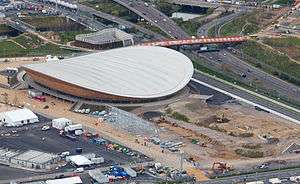Rainwater harvesting in the United Kingdom
Rainwater harvesting (RWH) is a practice of growing importance in the United Kingdom, particularly in the South East of England where there is less water available per person than in many Mediterranean countries.[1] Rainwater harvesting in the UK is both a traditional and reviving technique for collecting water for domestic uses.[2] This water is generally used for non-hygienic purposes like watering gardens, flushing toilets, and washing clothes.[3] There is a growing demand for larger tank systems collecting between 1000-7500 litres of water. The two main uses for harvested rainwater are botanical uses, like gardening for plant irrigation, and domestic uses, like flushing toilets and running washing machines. Rainwater is almost always collected strictly from the roof, then heavily filtered using either a filter attached to the down pipe, a fine basket filter or for more expensive systems like self-cleaning filters placed in an underground tank. UK homes using some form of rainwater harvesting system can reduce their mains water usage by 50% or more.[4]
History

Prior to the widespread use of water mains, RWH was a traditional means of getting water in the UK.[2] Even as far back as the 2nd-century AD, archaeological evidence shows that rainwater harvesting was being used by Housesteads Roman Fort in Northumberland as a way to flush the latrines.[5] English castles from the 12th and 13th-century also have notable rainwater harvesting systems, such as Carreg Cennen,[6] Orford,[7] and Warkworth Castle.[8]
In the 19th and the early 20th century, prior to widespread access to water mains, most large middle-class homes got their drinking water from springs and wells, but this water was usually hard which made it unsuitable for washing. Thus, such homes were usually designed to also harvest rainwater to be used in washing.[9] During the interwar period, houses in hard water areas were sometimes built with rainwater storage tanks forming the roof of a scullery. Rainwater was led down to a third tap for washing purposes. Rainwater harvesting declined in popularity as water mains became more widespread through the early 20th century onwards.
Current status

In recent years, rainwater harvesting has become more common due to increasing water prices. While rainwater harvesting has been employed in high-profile facilities like the velodrome of the London Olympic Park, the UK's ongoing revival has lagged behind other countries such as Germany (the present world leader in modern rainwater harvesting).[10] At present, only about 400 RWH systems are installed in the UK every year.[2]
Rainwater harvesting is being encouraged by the government of the UK through the Code for Sustainable Homes. The code ranks homes on a scale of one through six and requires new homes to have a score of at least three. One way to raise the score of a newly designed home is to incorporate a rainwater harvesting system.[11]
The Environment Agency has noted that water resources in the UK are under increasing pressure because of the growing population. In addition, the agency has warned that the South East of England is facing more serious water scarcity than anywhere else in England or Wales, such that the per-capita water supply is lower than many Mediterranean countries. The agency encourages a two-pronged approach to both reduce demand and increase supply, such as through the use of rainwater harvesting.[1]
See also
- Rainwater harvesting
- Climate of the United Kingdom
- Northern Ireland water shortages
- Drought in the United Kingdom
- Rainwater harvesting in Kerala
- Air well (condenser)
References
- 1 2 "Harvesting rainwater for domestic uses: an information guide" (PDF). Environment Agency. October 2010. p. 4. Retrieved 2012-08-13.
- 1 2 3 "Harvesting rainwater for domestic uses: an information guide" (PDF). Environment Agency. October 2010. pp. 22–23. Retrieved 2012-08-13.
- ↑ "Rainwater Harvesting and Uses in your household".
- ↑ "Rainwater harvesting". SVCwater. Retrieved 2013-07-27.
- ↑ "English Heritage Teacher's Kit - Housesteads Roman Fort" (PDF). English Heritage. July 2012. p. 5. Retrieved 2012-08-13.
- ↑ "Carreg Cennen Castle". Castles of Wales. 2009. Retrieved 2012-08-13.
- ↑ "English Heritage Teacher's Kit - Orford Castle" (PDF). English Heritage. January 2000. pp. 3, 7. Retrieved 2012-08-13.
- ↑ "English Heritage Teacher's Kit - Warkworth Castle" (PDF). English Heritage. May 2011. p. 5. Retrieved 2012-08-13.
- ↑ Eveleigh, David J. (2006). "Evolution of Building Elements - The Services of Victorian and Edwardian Houses 1850-1914". University of the West of England Faculty of Environment and Technology. Retrieved 2012-08-13.
- ↑ "Learning legacy - Rainwater harvesting at the Velodrome" (PDF). Olympic Delivery Authority. October 2011. Retrieved 2012-08-13.
- ↑ "Rainwater Harvesting: Environmental and Regulatory Aspects" (PDF). RainWater-Harvesting. October 2008. pp. 3–4. Retrieved 2012-08-14.